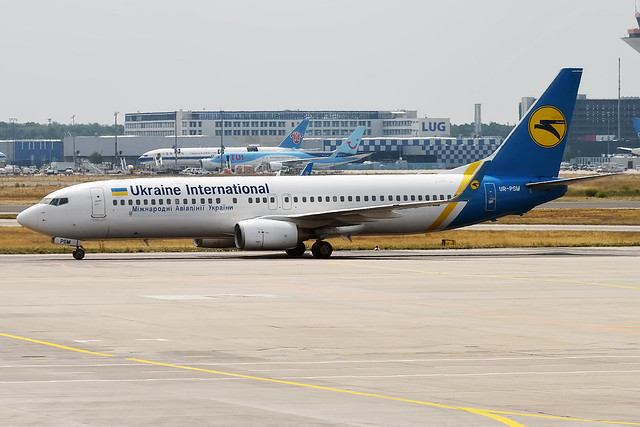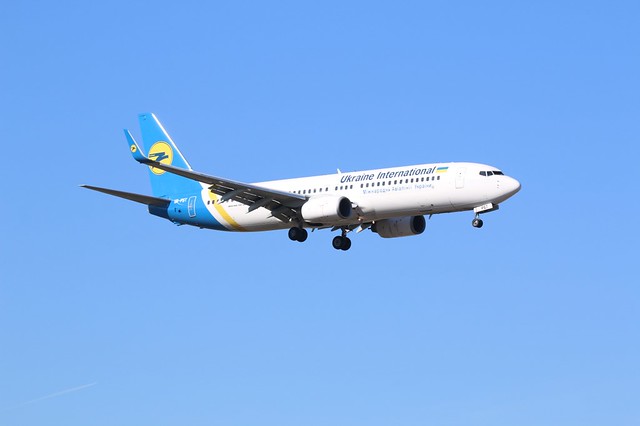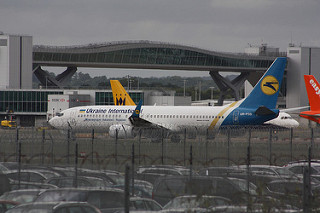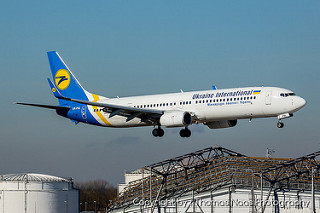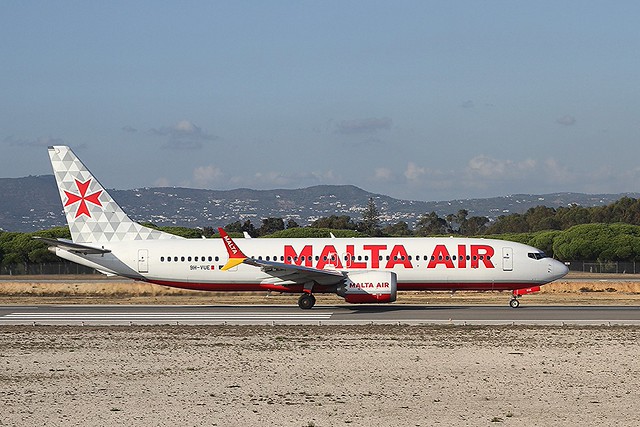Ukraine International B733 at Kiev on Jan 16th 2016, runway excursion on landing
Last Update: December 1, 2016 / 20:52:14 GMT/Zulu time
Incident Facts
Date of incident
Jan 16, 2016
Classification
Incident
Cause
Runway excursion
Airline
Ukraine International Airlines
Aircraft Registration
UR-GBA
Aircraft Type
Boeing 737-300
ICAO Type Designator
B733
The cause of the runway excursion was the not full and untimely use of reversers and brakes by the crew:
- Setting of autobrakes to 2 while landing on a slippery runway
- exaggerated planning speed of Vapp=Vref+11
- touchdown at Vref+6
- shortcomings in crew training with respect to computation of required landing distance versus landing distance available, in this case landing with 8 knots tailwind, decreasing braking action in the last 100 meters of runway as well as possible crew fatigue as result of failure to comply with rest.
The NBAAI analysed that the aircraft was on approach to Borispil Airport when ATC informed the crew that snow recovery works were in progress and queried whether they could accept 30 minutes of holding time at 06:53Z. The crew accepted the holding time but one minute later changed their mind and requested to divert to Kharkov reasoning that even after 30 minutes it would not be ensured Borispil's runway 18L would be acceptable. The aircraft was cleared to divert to Kharkiv and climbed out of Kiev. The snow fall turned into heavy rain and Borispol Airport managed to clear runway 18L anticipating to open the runway shortly. The crew was informed about the changed state and was told they could plan Zhulyani as backup at 07:06Z. At 07:08Z the crew advised they would commence the approach to Borispol, landing was estimated in 30 minutes. The aircraft was cleared back to Kiev and to descend. While descending towards Kiev ATC queried the available holding time at 07:18Z, the crew advised they had now 20 minutes of holding time available, ATC advised that Borispol would open their runway only in 30 minutes. The crew computed their fuel status for Kharkov and found they would arrive at Kharkov with only 2900kg of fuel remaining, which was insufficient as 2900kg were required to remain ((the investigation determined the amount required after landing would actually have been 2400kg). At 07:22Z the commander therefore decided to divert to Kiev's Zhuliany Airport.
The landing distance available at Zhuliyani's runway 08 was 2160 meters, the landing distance required was 1933 meters anticipating medium to good braking action, that had been reported by a previous landing, an Antonov 24, at Zhuliany. This required landing at full flaps, Vref and maximum autobrakes, the crew however used flaps at 30 degrees, Vref+11 and autobrakes at position 2. The NBAAI analysed that given the pilot report of braking action available the crew did not appreciate the complexity of the landing on Zhuliyani's short runway 08 that was covered with snow. The crew had no experience with short landings (the shortest runway they had landed on was 2500 meters in length), in addition it was the first landing at Zhulyiani for the crew.
The NBAAI analysed further during rollout at 07:42 the crew commented "this is autobrakes 2 but we must go".
The NBAAI analysed that the flight data showed the aircraft achieved a longitudinal deceleration of 0.15G which is close to the commanded longitudinal deceleration (autobrakes 2) of 0.155G. The runway coefficients were measured at 0.26/0.26/0.26, poor to medium braking action, the runway was covered with 5mm of snow, the airport was transmitting information of an earlier measurement indication indicating the runway was covered with snow with braking coefficients at 0.35/0.35/0.35. When the NBAAI took measurements following the occurrence the average coefficient between point of touchdown and point of stop was determined at 0.15 just above mean (0.10), only between 5600 and 7000 feet down the runway the coefficient reached 0.35.
When the aircraft touched down the crew felt the runway was slippery. The NBAAI analysed that the crew stowed the thrust reversers at 64 knots and stated this was not in line with the operating manual requiring full use of brakes and reversers while landing on slippery runways.
The NBAAI analysed the aircraft came to a stop 52 meters past the end of the runway and 47 meters to the left of the extended runway center line.
The NBAAI analysed that due to the fact that three SNOWTAMs (no 154, 155 and 156) were prepared in Kyrillic, the machinery however only accepted the SNOWTAMs in Latin characters, the three SNOWTAMs (no 154 giving the runway coefficients at 0.26/0.26/.026) were not transmitted, while previous SNOWTAMs reported coefficients of 0.5/0.5/0.5 and 0.38/0.38/0.38.
The NBAAI summarized that the airport only had 2 of 4 devices to measure brake coefficients that confirmed to the standards. There were no measurements 30 minutes prior to the landing. The airport thus did not draw the attention of the crew to the slippery condition of the runway.
(Editorial note: in the extensive, highly complex analyis of the braking coefficients spanning more than a dozen pages and very difficult to follow The Aviation Herald expected to but could not find a computation suggesting the landing distance required for the actual configuration of the aircraft based on the data provided by the airport and based on the actual braking coefficients determined following the occurrence).
Incident Facts
Date of incident
Jan 16, 2016
Classification
Incident
Cause
Runway excursion
Airline
Ukraine International Airlines
Aircraft Registration
UR-GBA
Aircraft Type
Boeing 737-300
ICAO Type Designator
B733
This article is published under license from Avherald.com. © of text by Avherald.com.
Article source
You can read 2 more free articles without a subscription.
Subscribe now and continue reading without any limits!
Read unlimited articles and receive our daily update briefing. Gain better insights into what is happening in commercial aviation safety.
Send tip
Support AeroInside by sending a small tip amount.
Related articles
UIA B738 near Odessa on May 20th 2021, engine shut down in flight
A UIA Ukraine International Airlines Boeing 737-800, registration UR-PSM performing flight PS-712 from Istanbul (Turkey) to Kiev (Ukraine), was…
UIA B738 at Lviv on Nov 23rd 2019, runway excursion during line up
An UIA Ukraine International Airlines Boeing 737-800, registration UR-PST performing flight PS-34 from Lviv to Kiev (Ukraine) with 157 people on…
UIA B738 at Paris on Nov 11th 2018, navigation error
A UIA Ukraine International Airlines Boeing 737-800, registration UR-PSB performing flight PS-128 from Paris Charles de Gaulle (France) to Kiev…
UIA B763 at Kiev on Jul 29th 2019, engine shut down in flight
A UIA Ukraine International Airlines Boeing 767-300, registratio UR-GEC performing flight PS-271 from Kiev (Ukraine) to Bangkok (Thailand), was…
UIA B739 at Lviv on Jul 30th 2018, bird strike
An UIA Ukraine International Airlines Boeing 737-900, registration UR-PSL performing flight PS-5265 from Lviv (Ukraine) to Sharm el Sheikh (Egypt),…
Newest articles
Malta B38M at Krakow on Dec 8th 2025, sun visor temporarily shuts engine down
An Air Malta Boeing 737-8 MAX on behalf of Ryanair, registration 9H-VUE performing flight FR-3505 from Krakow (Poland) to Milan Bergamo (Italy), was…
Hokkaido AT42 at Okushiri on Dec 16th 2025, problems with left aileron
A Hokkaido Air System Avions de Transport Regional ATR-42-600 on behalf of JAL Japan Airlines, registration JA13HC performing flight JL-2891 from…
Subscribe today
Are you researching aviation incidents? Get access to AeroInside Insights, unlimited read access and receive the daily newsletter.
Pick your plan and subscribePartner

ELITE Simulation Solutions is a leading global provider of Flight Simulation Training Devices, IFR training software as well as flight controls and related services. Find out more.
SafetyScan Pro provides streamlined access to thousands of aviation accident reports. Tailored for your safety management efforts. Book your demo today
AeroInside Blog
Popular aircraft
Airbus A320Boeing 737-800
Boeing 737-800 MAX
Popular airlines
American AirlinesUnited
Delta
Air Canada
Lufthansa
British Airways









